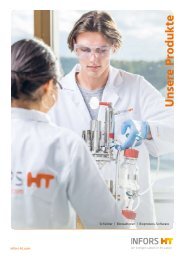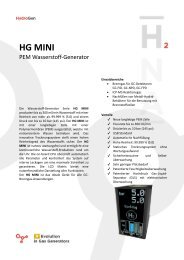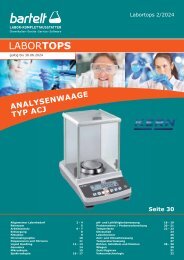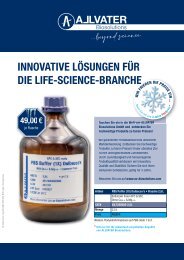Cleaver Scientific Produktkatalog
You also want an ePaper? Increase the reach of your titles
YUMPU automatically turns print PDFs into web optimized ePapers that Google loves.
Blot Transfer Systems<br />
Electroblotting is a technique to immobilise proteins or nucleic acids on a solid<br />
membrane support. Samples are then detected using specific antibodies, ligands or<br />
nucleic acid probes that bind to individual proteins or nucleic acid sequences. This allows<br />
identification, quantification or interaction studies of proteins and nucleic acid from<br />
various samples, and makes it a powerful technique in proteomics and genomics.<br />
<strong>Cleaver</strong> <strong>Scientific</strong> offers four types of system:<br />
MODULAR ELECTROBLOTTERS – combine PAGE and transfer<br />
techniques within the same tank. These options are shown in the<br />
PAGE vertical sections<br />
TANK TRANSFER SYSTEMS – available with either plate or wire<br />
electrodes, support efficient, quantitative transfers over a wide<br />
molecular weight range. Plate electrode systems are faster through<br />
greater field strength; wire electrodes are more economical,<br />
consuming less current and generating less heat.<br />
SEMI-DRY TRANSFER SYSTEMS – perfect for rapid, high-intensity<br />
transfers of mid-range proteins, 10-100kD in size.<br />
MICROFILTRATION (DOT AND SLOT BLOTTING) – does not require<br />
electrophoresis and is used to determine the working conditions<br />
for a new blotting assay, antibody titres and antibody-antigen<br />
specificity. Also suitable for nucleic acids<br />
Electroblotters<br />
Designed primarily for wet electroblotting of proteins, these Electroblotters offer a<br />
combination of increased capacity with economy saving features.<br />
Both units, Mini 10 x 10cm and Maxi 20 x 20cm, have increased capacity over standard<br />
systems with up to five gel blot cassettes utilised at any one time. This is especially useful in<br />
high throughput laboratories.<br />
A uniform electric field is provided by a high intensity coiled electrode and ensures uniform<br />
transfer across the blot surface. The cassette’s open architecture ensures the maximum<br />
blot area allows direct transfer of current. Its rigid construction ensures contact between<br />
the gel and membrane is retained throughout the blot and an even pressure is<br />
maintained. These units are<br />
compatible with magnetic stirrers<br />
to aid heat dispersal and prevent<br />
pH drifts in the buffer due to<br />
incomplete buffer mixing. Each<br />
system includes a cooling pack to<br />
further enhance transfer efficiency<br />
by removing excess heat. This also<br />
saves on buffer for added<br />
economy.<br />
KEY FEATURES<br />
• Ideal for wet electroblotting of proteins -<br />
Western blotting<br />
• Up to five gel blot cassettes utilised at<br />
any one time<br />
• Hinged cassettes for added<br />
convenience<br />
•<br />
Accommodates gel thicknesses from<br />
0.25 up to 3mm<br />
TECHNICAL SPECIFICATIONS<br />
Unit dimensions Mini 19 x 13 x 19cm<br />
(W x D x H) Maxi 24 x 16 x 26cm<br />
Max. sample Mini 5 Blots, 10 x 10cm<br />
capacity Maxi 5 Blots, 20 x 20cm<br />
20 Blots, 10 x 10cm<br />
Buffer volume Mini Min 1000ml; Max 1500ml<br />
Maxi Min 4300ml; Max 6000ml<br />
double hinged cassettes<br />
for added convenience<br />
ORDERING INFORMATION<br />
EBM10<br />
EBM20<br />
Mini ElectroBlotter, 10 x 10cm System for five cassettes,<br />
with tank and lid, 5x cassettes, 12x fibre pads and cooling pack<br />
Maxi ElectroBlotter, 20 x 20cm System for five cassettes,<br />
with tank and lid, 5x cassettes, 12x fibre pads and cooling pack<br />
SB10C<br />
SB10F<br />
SB20C<br />
SB20F<br />
Mini Cassette<br />
Fibre pads - pk/8<br />
Maxi Cassette<br />
Fibre pads - pk/6

















